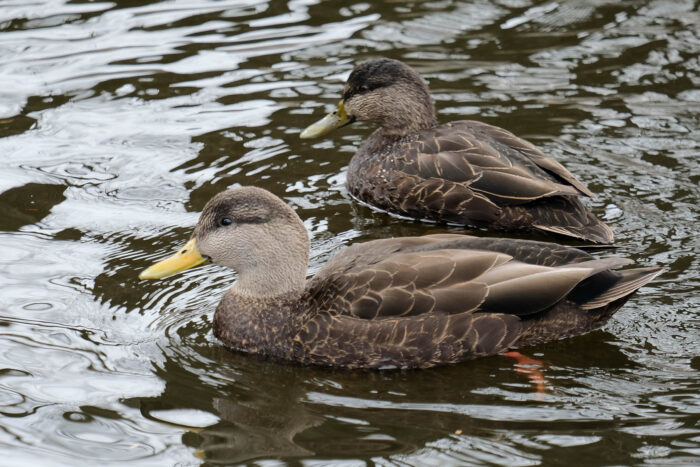American Black Duck
Anas rubripes
The American black duck is a dusky brown dabbling duck that appears black from a distance. It lives year-round along the quiet, isolated tidal wetlands of the Chesapeake Bay and its rivers.
This section shows one large critter image at a time. Use the thumbnails that follow to select a specific image to display here.

This gallery contains a grid of small thumbnails. Selecting a thumbnail will change the main image in the preceding section.
Appearance
Not truly black, the American black duck has dark, dusky brown plumage that appears black from a distance. It has a pale brown head with a black streak through the eyes. Its bill is yellowish in color and it has reddish or orange legs and feet. Its wings have purplish patches (called specula) and white wing linings. Males and females look alike, except females have a mottled bill. Males resemble female mallards. Black ducks grow to about 25 inches with a wingspan of 36 inches.
Feeding
This duck eats seeds, bay grasses, aquatic plants and small invertebrates, and will also eat grains, nuts and corn from farm fields. It feeds at the water’s surface or by “tipping up” its tail and submerging its head to reach food underwater.
Predators
Humans are black ducks’ greatest predator. Other predators may include snakes, skunks, crows, raccoons and opossums.
Flight
The black duck takes off by flying straight up from the water. It can be identified in flight by its black body, contrasting white wing linings and purple wing patch.
Voice
Black ducks sound similar to a mallard: males make a kwek-kwek sound, while females quack.
Reproduction and life cycle
Pairs start forming in autumn. Black ducks begin nesting in mid-March in dense, secluded marshes and forested wetlands. In the Chesapeake region, most black duck nests are located on Maryland’s Eastern Shore and near the Potomac, Rappahannock, York and James rivers. Nests are made in a tree cavity or a depression on the ground. The female lays 6 to 12 buff green eggs that hatch in 28 days. The male leaves the female about two weeks after she lays her eggs. She raises their young on her own. After hatching, the female leads her young to a nearby marsh. Ducklings feed on grasses, insect larvae and other small invertebrates. Young are ready to fly about two months after hatching.
Did you know?
- Black ducks are very closely related to mallards. It is not uncommon for mallards and black ducks to breed, which produces mallard/black duck hybrids that have physical characteristics of both ducks.
- More than 200,000 black ducks used to winter in the Chesapeake region. Today, fewer than 52,000 visit the region each winter. Scientists believe this is due to loss of food and habitat, as well as heavy hunting pressure and interbreeding with mallards.
- The Chesapeake Bay Program has an outcome to restore, enhance and preserve wetland habitats that support a wintering population of 100,000 black ducks.
- They can be confused with female mallards. You can identify a black duck by its darker overall coloring. Black ducks are also significantly less common than mallards.
Sources and additional information
- Life in the Chesapeake Bay by Alice Jane Lippson and Robert L. Lippson
- Chesapeake Bay: Nature of the Estuary, A Field Guide by Christopher P. White
- Animal Diversity Web: Anas rubripes – University of Michigan Museum of Zoology
- Waterfowl ID: American Black Duck – Ducks Unlimited
- NatureWorks: American Black Duck – New Hampshire Public Television
- Index of Species Information: Anas rubripes – U.S. Forest Service
